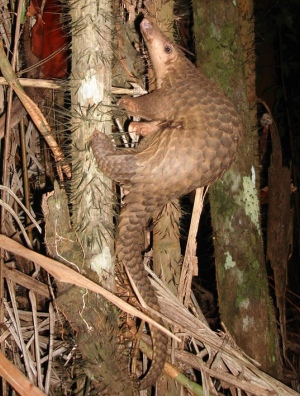Breaking up the rainforest into small, isolated patches puts pressure on species that rely on the forest core, but benefits those who like the edges.
Half the world’s forest habitat is now within 500m of a ‘forest edge’ due to the expansion of road networks, logging, agriculture and other human activity. These edges look different to the rest of the forest: they have more light, less moisture and generally higher temperatures.
Tropical forests and the animals they harbour are being lost at alarming rates but in order to protect them we need to know exactly how fragmentation of the land is impacting on the animals that live there.
– Dr Marion Pfeifer
Research published today in Nature highlights how biodiversity is changing as a result of forest fragmentation, which could inform forest conservation and restoration efforts.
Collecting data for over 1,500 forest vertebrates (animals with backbones), the research team led by Imperial College London and Newcastle University found that 85 per cent of species are now being impacted by forest fragmentation.
Roughly half of them are losers: they need the dense forest core to survive and are being squeezed into ever smaller areas. This leads to some of them becoming endangered, such as the long-billed black cockatoo.
The other half are winners: they like conditions at the edges and are thriving. However, these species are not necessarily ones that benefit the local ecosystem. Some are invasive species that are not native to the area, such as feral dogs in some parts of North America.
Study author Professor Robert Ewers, from the Department of Life Sciences at Imperial, said: “The winners and losers aren’t equal. Some of the species that like edges are invasive like the boa constrictor, while the ones huddled into the deep forest are more likely to be threatened with extinction – like the Sunda pangolin.”
Senstivie species
Many of the species studied were in tropical forests, since this is where much current deforestation is taking place. Dr Marion Pfeifer, lead author based at Newcastle University, said: “Tropical forests and the animals they harbour are being lost at alarming rates but in order to protect them we need to know exactly how fragmentation of the land is impacting on the animals that live there.

Sunda pangolins are endangered species that love the forest core. Credit: Piekfrosch, Wikimedia Creative Commons
“This is critical for the hundreds of species that we identified as being clearly dependent on intact forest core areas – that is forest which is at least 200-400m from the edge. These species were highly sensitive to the changing habitat and therefore more likely to disappear in landscapes that encompass only a small proportion of intact forest.”
The team collected species’ abundance data from 22 fragmented landscapes worldwide, across seven major biogeographic realms, including tropical and temperate forests. They analysed 1,673 species of mammals, birds, reptiles and amphibians to see how they respond to edges.
They found that edge effects create species communities near edges that bear little resemblance to the communities of forest interiors, and this species turnover likely reflects dramatic changes to the ecological functioning of modified forest habitats.
Guiding conservation efforts
Importantly, the team has developed a system that allows them to predict which species are likely to disappear first from our changing forest habitats, informing conservation strategies.
Dr Pfeifer said: “Our analysis allows us to track species’ abundances in response to edge effects to predict the impact on biodiversity caused by forest loss and fragmentation.
“This is useful for land management and as a tool to help guide our conservation efforts. The next step is to use this data and our software to allow managers to create ‘optimal landscapes’ that combine forest use with biodiversity conservation.”
-
‘Creation of forest edges has a global impact on forest vertebrates’ by Pfeifer et al. is published in Nature.
Supporters

Article text (excluding photos or graphics) available under an Attribution-NonCommercial-ShareAlike Creative Commons license.
Photos and graphics subject to third party copyright used with permission or © Imperial College London.
Reporter
Hayley Dunning
Communications Division

Contact details
Tel: +44 (0)20 7594 2412
Email: h.dunning@imperial.ac.uk
Show all stories by this author




Leave a comment
Your comment may be published, displaying your name as you provide it, unless you request otherwise. Your contact details will never be published.